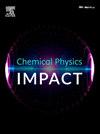Pharmacophore-based approach for the identification of prospective UDP-2,3-diacylglucosamine hydrolase (LpxH) inhibitor from natural product database against Salmonella Typhi
IF 3.8
Q2 CHEMISTRY, PHYSICAL
引用次数: 0
Abstract
Antibiotics are essential for the treatment of typhoid fever, which is caused by Salmonella Typhi. The global increase of antibiotic resistance in S. Typhi is a significant public health threat. The traditional approach to discovering new drugs is a lengthy process. To address this, ligand-based pharmacophore modeling was used to identify potential inhibitors of the S. typhi LpxH protein, a crucial enzyme in the lipid A biosynthesis pathway. A natural compound library of 852,445 molecules was screened against a pharmacophore model developed from known LpxH inhibitors. Further, virtual screening, molecular docking, and MD simulation (100 ns) studies identified two lead compounds, 1615 and 1553. A comparative analysis of both molecules showed that compound 1615 exhibited the highest stability, with the lowest potential energy, minimal fluctuations, and stable hydrogen bonding, indicating strong binding at the active site. Compound 1553 also demonstrated good stability, though with slightly higher fluctuations. Both compounds underwent toxicity prediction and ADMET analysis, showing favorable drug-like properties, with compound 1615 emerging as the most promising inhibitor due to its optimal electronic energy and minimal chemical potential. The study concluded that compounds 1615 and 1553 hold significant potential as lead molecules for developing new treatments against drug-resistant S. Typhi infections. This study illustrates how computational techniques, such as MD simulations and pharmacophore modeling, can speed up drug discovery, especially in the fight against antibiotic resistance.

基于药效团的方法从天然产物数据库中鉴定抗伤寒沙门氏菌的潜在udp -2,3-二酰基葡萄糖胺水解酶(LpxH)抑制剂
抗生素对于治疗伤寒是必不可少的,伤寒是由伤寒沙门氏菌引起的。全球伤寒沙门氏菌抗生素耐药性的增加是一个重大的公共卫生威胁。发现新药的传统方法是一个漫长的过程。为了解决这个问题,基于配体的药效团模型被用于鉴定伤寒沙门氏菌LpxH蛋白的潜在抑制剂,LpxH蛋白是脂质a生物合成途径中的关键酶。从已知的LpxH抑制剂开发的药效团模型中筛选了852,445个天然化合物文库。此外,虚拟筛选、分子对接和MD模拟(100 ns)研究确定了两个先导化合物1615和1553。两种分子的对比分析表明,化合物1615具有最高的稳定性,势能最低,波动最小,氢键稳定,表明活性位点结合强。化合物1553也表现出良好的稳定性,尽管波动略高。两种化合物均进行了毒性预测和ADMET分析,显示出良好的类药物性质,其中化合物1615因其最佳的电子能量和最小的化学势而成为最有希望的抑制剂。该研究得出结论,化合物1615和1553作为先导分子在开发抗耐药伤寒沙门氏菌感染的新疗法方面具有巨大的潜力。这项研究说明了计算技术,如MD模拟和药效团建模,如何加速药物发现,特别是在对抗抗生素耐药性方面。
本文章由计算机程序翻译,如有差异,请以英文原文为准。
求助全文
约1分钟内获得全文
求助全文
来源期刊

Chemical Physics Impact
Materials Science-Materials Science (miscellaneous)
CiteScore
2.60
自引率
0.00%
发文量
65
审稿时长
46 days
 求助内容:
求助内容: 应助结果提醒方式:
应助结果提醒方式:


